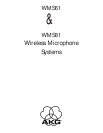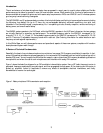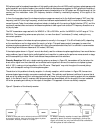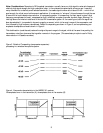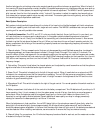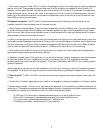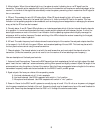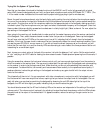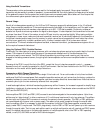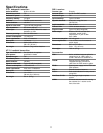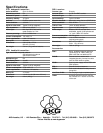
Using Handheld Transmitters:
The same setup routine and precautions as we used for the bodypack apply here as well. Since a given handheld
transmitter may be used by a number of speakers it is recommended that the initial checkout be made using the loudest
of the speakers to ensure that the system can handle those maximum speech peaks. Softer talkers will then require that
the reinforcement system operator raise input levels at the console as required.
General Usage:
As with all wireless systems operating in the VHF and UHF frequency ranges with radiated power in the 10 milliwatt
range, there are certain precautions. If the receiving antennas are line-of-sight to the transmitters, and if the path is open
and free of large steel structural members, clear operation up to 500 - 1000 feet is possible. Curtains do not pose an
obstacle, but drywall structures may weaken the signal to some degree. It is also important that transmitters not be used
any closer than about 10 feet of the receiver, since the RF input circuitry may overload slightly. When testing multiple
microphones in a new venue, make sure that each transmitter/receiver pair is individually tested with the transmitter at
the farthest intended position away from the receiver. In certain venues, some frequencies will work better than others,
and this is your opportunity to detect a problem and fix it before it causes trouble. All of us have seen national
conventions on TV where a wireless microphone has failed, or become intermittent, just because some engineer did not
do the required homework beforehand.
Using the Optional PR 81 Portable Receiver:
Traditionally, the video taping of a roving announcer with a wireless microphone required a wire audio feed to the video
camera. This nuisance of course limited the range of the camera and defeated much of the effectiveness of the
announcer’s need to move around. The PR 81 solves this problem by providing a small receiving unit that can be
strapped to the battery-powered camera, thus giving both camera operator and announcer complete freedom to move as
needed.
The setup of the PR 81 is much like that of the SR 81, except that the unit does have a squelch control — necessary
because the unit will normally be operated in a high RF environment. See the Users Instructions for the PR 81 for added
information on this model. and for specific setup instructions.
Comments on Multi-Channel Operation:
Two SR 61 or 81 units can be joined to fit into a single 19-inch rack unit. For an odd number of units, there is a blank
metal panel that fills the unused space. Each complete transmitter-receiver pair, as it arrives from the factory, contains the
necessary hardware to mount two receivers together, and there is a setup sheet that shows details here. Note that there is
a common yoke to join the two receivers by screws at their rear panels.
In small-scale applications, individual free-standing systems may suffice. However, for increased range and to simplify large
installations, a single pair of antennas may be used with multiple receivers. These booster antenna models are the RA61B
(VHF) and the RA 81B (UHF).
Antenna splitters PS61 (VHF) and PS81 (UHF) are used to send antenna signals to the connected systems. Up to three
splitters may be “daisy-chained” to allow a maximum of 10 multichannel receivers with only two antennas. The splitters
use two input and 8 output BNC connectors to maintain the systems’ diversity operation. The PS61 or PS81 splitters do
not come shipped with a power cord or power supply. The reason is that power is supplied through the coaxial cable
from the receivers. When it is necessary to eliminate the receivers’ individual 12Vdc power supplies, a central power
supply (model PSU01) may be used. The PSU01 plugs directly into the PS61 or PS81 and will power up to four receivers
through the coaxial cable. That is to say, each splitter used in a multiple configuration set will required one PSU01 power
supply. For detailed instructions on the setup and operation of multiple systems, refer to the PS61 or PS81 operating
manual, or call (615) 360-0499 and ask for AKG technical support.
10



